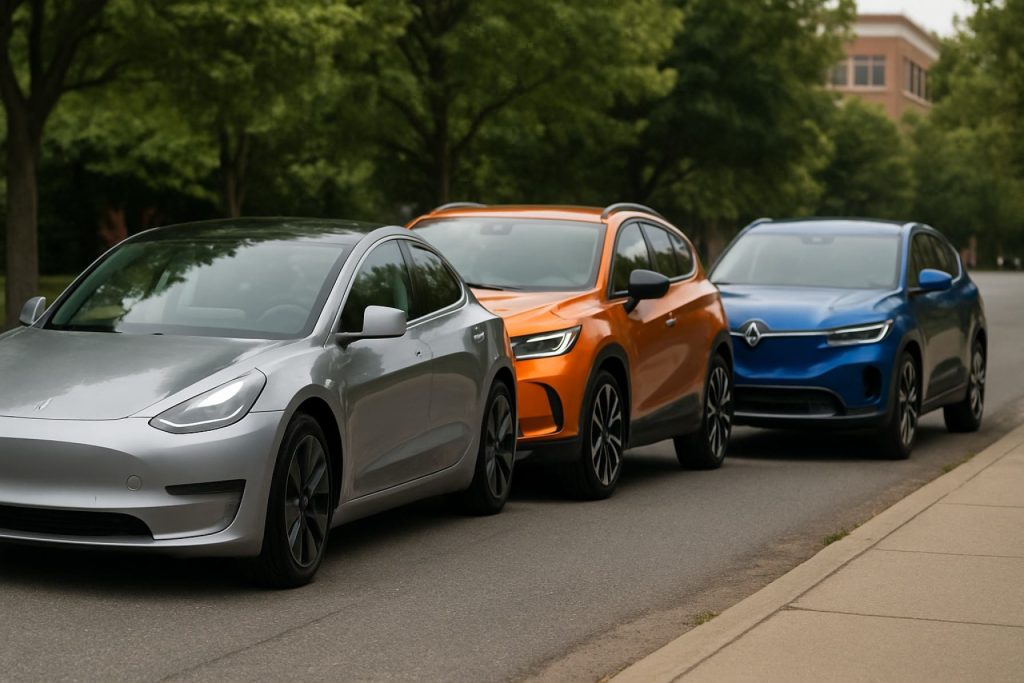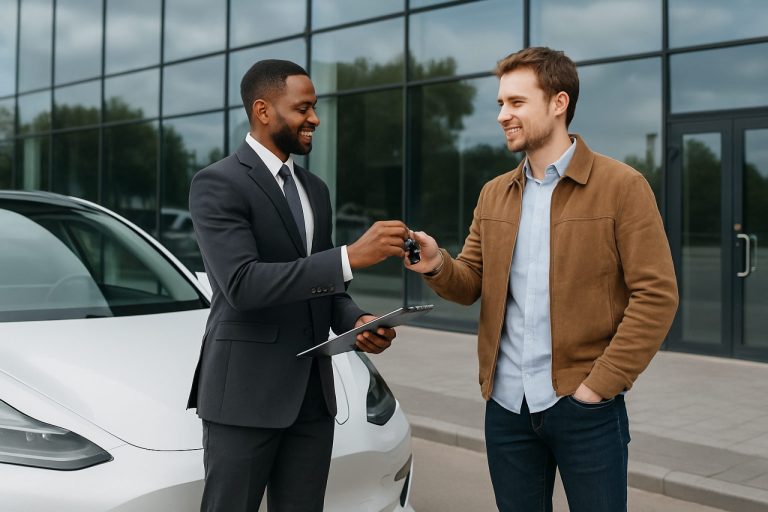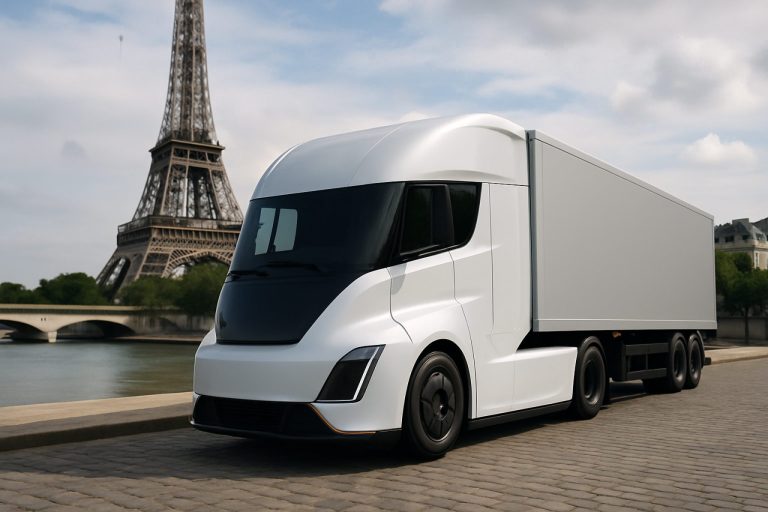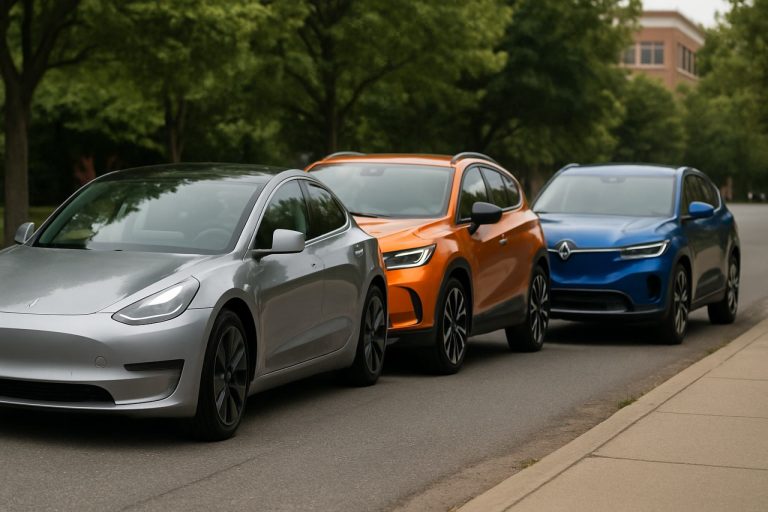
- The U.S. electric vehicle (EV) market now features diverse options from global brands like Hyundai, Kia, BMW, Ford, Lucid, and Polestar, not just Tesla.
- Consumers are motivated by personal values, design preference, and practicality, marking a shift away from Tesla’s dominance.
- Emerging EV models deliver competitive driving range, innovative technology, and distinctive styling—often at more affordable prices.
- Luxury and performance are no longer exclusive to Tesla; vehicles like the Lucid Air, Porsche Macan EV, and Rivian R1S set new benchmarks.
- Automakers prioritize user experience, offering choices that suit individual lifestyles, from family SUVs to sporty sedans and practical crossovers.
- Choice, innovation, and personal expression now define the rapidly evolving EV landscape, making it easier than ever to find a model that fits your needs.
Electric vehicles no longer belong to a single brand, nor do their owners. Tesla’s once-unshakable grip on the American EV landscape is loosening, as drivers increasingly ditch the familiar for an electrified world teeming with fresh choices. The parking lots tell the story—shiny new contenders from Europe, Korea, and Detroit have begun to outnumber the Model 3s and Model Ys that once symbolized a movement.
Walk through any urban charging station, and you’ll notice it’s not just the bustling allure of Tesla’s Superchargers pulling in a crowd. Now, Hyundai’s angular Ioniq 5s recline alongside the athletic Kia EV6s, their bold designs a quiet rebellion against minimalism. The Genesis GV60 glimmers in muted metallics, evoking the luxury once reserved for the highest Tesla trims. BMW injects its storied engineering into the i4 and i5, offering the precision and comfort that German sedans are revered for—but this time without a whiff of gasoline.
Tesla still claims more than 40% of all electric vehicles sold in the U.S. last year, as reported by Cox Automotive. Yet, shoppers are no longer starved for options. Concerns about Elon Musk’s attention-grabbing politics or the cultural baggage attached to the Tesla brand have nudged many to seek alternatives. An electric vehicle purchase in 2024 is a personal statement—one that resonates with both values and practicality.
The next wave of electric cars doesn’t just chase range or speed; these vehicles challenge Tesla on user experience. Hyundai’s Ioniq 5 N—a thrilling performer reputed to rival even the wildest Italian exotics—offers technology, comfort, and playful “drift modes” that invite fun back into daily commutes. The Kia EV6 and Ford Mustang Mach-E expertly blend style and substance, standing tall on their own merits rather than simply mimicking market leaders.
Inside the showrooms, sales reps are happy to pitch the Chevrolet Equinox EV as the “people’s electric car”: 300 miles of range, a refined interior, and a starting price so low—around $33,600, less with incentives—that it undercuts most gasoline SUVs. Meanwhile, Porsche’s Macan EV turns heads with a sound system good enough to make music lovers abandon concerts altogether. The Volvo EX30 has reimagined what a compact crossover can be, boasting 422 horsepower and zero-to-sixty acceleration that would embarrass sports cars twice its price.
For the sedan crowd, the Lucid Air rewrites the luxury playbook. This striking EV boasts up to 420 miles of range, lightning-fast charging, and ride refinement that outpaces the silkiest German limousines. Lucid’s “Wunderbox” recharges two hundred miles in barely the time it takes to grab a coffee. The supercharged Air Sapphire—with a 0-60 mph time under two seconds—is fast enough to make a seasoned sports car driver’s jaw drop, while the upcoming Lucid Gravity aims to channel supercar agility in SUV form.
America’s craving for big, family-sized EVs finally finds satisfaction in the Rivian R1S—an all-electric SUV beloved for software that updates as swiftly as Tesla’s and looks that turn sensible Range Rover buyers into EV evangelists. Not to be outdone, Polestar 3 uses Scandinavian sensibility and adaptive air suspension to entice the design set. Even Honda’s Prologue, built with General Motors’ formidable battery tech, allows those wary of complex screens to return to the comfort of physical buttons—all while emitting zero fumes.
A new era has dawned: Choice, innovation, and personal expression now define the EV market. As automakers old and new unveil models suited for every taste and budget, drivers are free to select not just an electric car, but an electric future that fits their own narrative.
Ready to explore the new electric vehicle landscape for yourself? Compare makes, read reviews and investigate incentives at major sources like Cars.com and Car and Driver.
Takeaway: The decision to go electric is no longer just about Tesla. Legacy marques and ambitious newcomers have delivered vehicles with dazzling performance, competitive pricing, and personalities to match yours. For shoppers, the most electrifying choice may be that there is—finally—a choice.
This Shocking EV Revolution Is Leaving Tesla in the Dust: 2024’s Best Electric Cars You’ve Probably Overlooked
The Expanding EV Universe: Why Your Next Car Might NOT Be a Tesla
The electric vehicle market in the U.S. is in the middle of a radical transformation. While Tesla still holds a significant share of the market—with over 40% of all EVs sold in 2023 according to analysts at Cox Automotive—the days of Tesla’s exclusive dominance are over. Legacy brands and ambitious startups are muscling in, with compelling models that push boundaries on style, performance, price, and tech.
Let’s dive into facts, features, and life-hacks every car shopper should know, referencing real-world use cases, expert insights, and the latest industry trends for 2024.
Beyond Tesla: New EV Contenders Redefine the Market
Features, Specs & Pricing: What’s New and Exciting?
– Hyundai Ioniq 5 N: Recently crowned 2023 World Car of the Year, the Ioniq 5 offers unique retro design, ultra-fast 800V charging (18 minutes 10-80%), and up to 601hp in the N variant (Source: [InsideEVs](https://insideevs.com)). Its starting price is around $41,000 before incentives.
– Kia EV6: Shares architecture with the Ioniq 5, but boasts a sleeker “crossover coupe” body. Fastest “GT” version goes 0-60 mph in 3.4 seconds, with a 274-mile base range.
– Ford Mustang Mach-E: Offers both standard (250 miles) and extended range (up to 310 miles). Eligible for the full $7,500 federal tax credit in 2024. Prices begin around $39,000 before incentives.
– Chevrolet Equinox EV: Stands out as one of the most affordable options—base price of $33,600, range up to 300 miles, eligible for U.S. tax incentives.
– Porsche Macan EV: Porsche’s performance DNA with an 800V architecture carried over from the Taycan. The Macan EV can recharge from 10-80% in about 21 minutes.
– Volvo EX30: Europe’s best-selling compact EV, now in the U.S., offers 268hp (single motor) or 422hp (dual motor), 0-60 in 3.4 seconds.
– Lucid Air: Sets segment benchmarks with a 516-mile EPA-rated range (Air Grand Touring), and a 0-60 time under 2 seconds in the Air Sapphire. Pricing starts at ~$77,400.
– Rivian R1S: Adventure-ready luxury SUV, with up to 400 miles of range (Max Pack), OTA updates, and true off-road ability.
– Polestar 3: A Scandinavian-designed luxury SUV with a minimalist interior and air suspension. 300+ mile range, starting at ~$80,000.
– Honda Prologue: First Honda EV built on a GM platform, 296-mile range, and analog-friendly controls plus Google built-in.
– Toyota bZ4X & Subaru Solterra: Joint venture all-wheel-drive compact SUVs; practical and built for reliability.
Real-World Use Cases & Life Hacks
– Commuters now have a choice of 250+ mile range EVs that can be fully charged overnight on a Level 2 home charger.
– Families can get all-electric 3-row SUVs (e.g., Kia EV9, Tesla Model X, Rivian R1S) for true replacement of gas-powered people haulers.
– Road-trippers benefit from rapidly expanding charging networks: Electrify America, EVgo, and, soon, Tesla Supercharger access for Ford, GM, Rivian, and others thanks to the NACS plug standard.
– Budget buyers can find used EVs under $25,000, many eligible for $4,000 used EV tax credits.
Market Forecast & Industry Trends
– EV sales in the U.S. breached the 1.2 million mark in 2023, with forecasters expecting 1 out of every 10 vehicles sold in 2024 to be electric.
– Adoption of the Tesla NACS Plug: Major automakers like GM, Ford, Hyundai/Kia, and BMW will integrate Tesla’s charging technology by 2025, accelerating interoperability and charging convenience.
– Battery advancements: New LFP (Lithium Iron Phosphate) batteries in many affordable EVs are safer and less prone to degradation than earlier chemistries ([Green Car Reports](https://greencarreports.com)).
Reviews & Comparisons
– Consumer Reports recently ranked the Hyundai Ioniq 6, Kia EV6, and Ford Mustang Mach-E highly for reliability—often surpassing Tesla in both predicted reliability and owner satisfaction.
– JD Power 2024 surveys show rising satisfaction with newer EVs’ infotainment systems and feature usability, but note learning curves for first-time owners.
– Edmunds praises the Lucid Air for luxury and driving experience, but cautions its reliability is unproven at mass volumes.
Controversies & Limitations
– Charging Infrastructure Disparities: Rural and remote areas still struggle with reliable, high-speed charging. Multibrand networks (Electrify America, EVgo) have reliability concerns.
– High Prices for Full-Size SUVs/Trucks: The segment-leading Rivian, GMC Hummer EV, and Ford Lightning surpass $70,000 in well-equipped trims.
– Resale Values: Some non-Tesla EVs see steeper initial depreciation, though this is moderating as the secondary market matures.
– Cold Weather Range Loss: All EVs lose some range in sub-freezing temperatures—plan accordingly for winter.
Security, Sustainability & Compatibility
– Over-the-air Updates: Many brands now offer OTA software, but patch policies and data privacy controls vary (see manufacturer documentation).
– Sustainable Materials: Volvo and Polestar are leaders in using recycled and vegan-friendly materials; Kia and Hyundai are catching up.
– Compatibility: By 2025, most new EVs using the NACS plug will directly access Tesla’s Supercharger network, eliminating one of Tesla’s key historic advantages.
Pros & Cons Quick Overview
| Pros | Cons |
|———–|—————-|
| Wide range of models and prices | Charging access varies regionally |
| Eligible for tax/subsidy incentives | Range can suffer in extreme weather |
| Lower maintenance costs than gas cars | Higher upfront cost for some models |
| OTA software, smarter features | Resale value fluctuation (some models) |
| Quieter, no tailpipe pollution | Fewer options for towing, heavy-duty use |
Most Pressing Reader Questions—Answered
1. Which EVs are eligible for the federal tax credit in 2024?
– Chevrolet Bolt, Equinox EV, Ford Mustang Mach-E, Tesla Model Y (some trims), and Volkswagen ID.4 meet manufacturing and battery sourcing requirements for the full $7,500 credit. Always verify latest eligibility list ([IRS](https://irs.gov)).
2. Can I take a non-Tesla on a long road trip?
– Yes. Ford, Hyundai, Kia, BMW, Rivian, and others are adding Supercharger access via adapters or NACS ports starting 2024-2025. Many plan trips with PlugShare, A Better Routeplanner, and similar apps.
3. Are non-Tesla EVs as reliable as Tesla?
– Recent reliability surveys from Consumer Reports favor Hyundai, Kia, and Toyota’s new EVs over Tesla. Tesla service and build quality can vary.
4. Will charging get easier soon?
– U.S. public charging points will surpass 200,000 by the end of 2024. Federal/state investments, plus the NACS transition, should rapidly improve reliability by 2025.
Actionable Recommendations & Quick Tips
1. Always test drive multiple EVs from different brands. Each has unique handling, interface, and comfort.
2. Check incentive eligibility at point of sale—not every EV or buyer qualifies for the same credits! Try the [official IRS site](https://irs.gov).
3. Download key EV planning apps (PlugShare, ABRP) before your first road trip.
4. Install a Level 2 charger at home if possible; it’s the best way to ensure your EV is always ready.
5. Monitor charging network expansion: If you rely on public charging, see if your most-traveled locations are on the map.
6. Browses reviews on Cars.com and Car and Driver to compare the latest models.
The Upward Trajectory Is Clear
With more choices, better tech, and increasing affordability, 2024 is the best year yet to make the switch to an EV—no matter your budget, taste, or driving habits. The question isn’t “Will you go electric?” It’s “Which EV will express the real you?” Keep an eye on industry leaders for updates and test drives.
The EV world is officially up for grabs!



